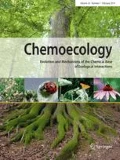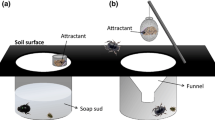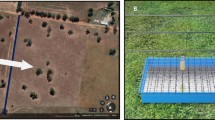Abstract
Volatile organic compounds (VOCs) provide animals with multiple cues about location, type, and condition of valuable resources such as food. In particular, odour cues are often essential for the localization and discrimination of resources with patchy distribution. Dung beetles (Scarabaeoidea) rely on such scented resources to locate food for their own diet and to provision their progeny. Despite the beetles’ mostly generalist choice across dung types, several studies showed that the beetles prefer some dung types over others. Yet, the importance of VOCs for dung localization and differentiation remains unclear. In this study, we used six single chemical components (indole, skatole, phenol, butyric acid, 2-butanone, and p-cresol), two different blends of these components, and six different dung types for a detailed behavioural analysis of dung beetles. We found very little specialization of beetle species towards specific VOCs. We found that dung baits and baits with synthetic compounds attracted similar communities of dung beetles, but the visitors of synthetic baits exhibited much lower diversity and abundance. The analysis of dung scent profiles of six types of dung revealed both, unique patterns in composition and ubiquitous components such as p-cresol. However, when we used a six-component blend of synthetic compounds, it turned out to be as attractive as three of the most attractive dung types in the field. Our findings highlight the significance of key VOCs, but, moreover, that dung beetles use a blend of specific components for resource localization.




Similar content being viewed by others
References
Blüthgen N, Menzel F, Blüthgen N (2006) Measuring specialization in species interaction networks. BMC Ecol 6:9
Blüthgen N, Menzel F, Hovestadt T, Fiala B, Blüthgen N (2007) Specialization, constraints, and conflicting interests in mutualistic networks. Curr Biol 17:341–346
Bunalski M (1999) Die Blatthornkäfer Mitteleuropas (Coleoptera, Scarabaeoidea): Bestimmung, Verbreitung, Ökologie. František Slamka
Chao A, Lee SM (1992) Estimating the number of classes via sample coverage. J Am Stat Assoc 87:210–217
Cosse AA, Baker TC (1996) House flies and pig manure volatiles: wind tunnel behavioral studies and electrophysiological evaluations. J Agric Entomol 13:301–317
Dormont L, Epinat G, Lumaret JP (2004) Trophic preferences mediated by olfactory cues in dung beetles colonizing cattle and horse dung. Environ Entomol 33:370–377
Dormont L, Rapior S, McKey DB, Lumaret JP (2007) Influence of dung volatiles on the process of resource selection by coprophagous beetles. Chemoecology 17:23–30
Dormont L, Jay-Robert P, Bessiere JM, Rapior S, Lumaret JP (2010) Innate olfactory preferences in dung beetles. J Exp Biol 213:3177–3186
Dötterl S, Wolfe LM, Jürgens A (2005) Qualitative and quantitative analyses of flower scent in Silene latifolia. Phytochemistry 66(2):203–213
Fischer M, Bossdorf O, Gockel S, Hänsel F, Hemp A, Hessenmöller D, Korte G, Nieschulze J, Pfeiffer S, Prati D (2010) Implementing large-scale and long-term functional biodiversity research: the biodiversity exploratories. Basic Appl Ecol 11:473–485
Frank K, Brückner A, Hilpert A, Heethoff M, Blüthgen N (2017a) Nutrient quality of vertebrate dung as a diet for dung beetles. Sci Rep 7:12147
Frank K, Hülsmann M, Assmann T, Schmitt T, Blüthgen N (2017b) Land use affects dung beetle communities and their ecosystem service in forests and grasslands. Agric Ecosyst Environ 243:114–122
Freude H, Harde KW, Lohse GA, Klausnitzer B (1969) Die Käfer Mitteleuropas. 8. Teredilia, Heteromera, Lamellicornia. Spektrum Akad. Verlag
Galante E, Cartagena MC (1999) Comparison of mediterranean dung beetles (Coleoptera: Scarabaeoidea) in cattle and rabbit dung. Environ Entomol 28:420–424
Gill BD (1991) Dung beetles in tropical American forests. In: Hanski I, Cambefort Y (eds) Dung beetle ecology. Princeton University Press, Princeton, pp 211–229
Hammer Ø, Harper DAT, Ryan PD (2001) PAST: paleontological statistics software package for education and data analysis–palaeontol. Electron 4:9
Hanski I, Cambefort Y (1991) Dung beetle ecology. Princeton University Press, Princeton
Inouchi J, Shibuya T, Hatanaka T (1988) Food odor responses of single antennal olfactory cells in the Japanese dung beetle, Geotrupes auratus (Coleoptera: Geotrupidae). Appl Entomol Zool 23:167–174
Jones R (2017) Call of nature: the secret life of dung. Pelagic Publishing Ltd, Exeter, UK
Klironomos JN, Widden P, Deslandes I (1992) Feeding preferences of the collembolan Folsomia candida in relation to microfungal successions on decaying litter. Soil Biol Biochem 24:685–692
Lumaret JP, Errouissi F, Floate K, Rombke J, Wardhaugh K (2012) A review on the toxicity and non-target effects of macrocyclic lactones in terrestrial and aquatic environments. Curr Pharm Biotechnol 13:1004–1060
Martín-Piera F, Lobo J (1996) A comparative discussion of trophic preferences in dung beetle communities. Miscellania Zoologica 19:13–31
Neier W, Strehlke G (2002) Ullmann’s encyclopedia of industrial chemistry. Wiley, Weinheim
Oksanen J, Kindt R, Legendre P, O’Hara B, Stevens MHH, Oksanen MJ, Suggests M (2007) The vegan package. Community Ecol Package 10:631–637
R Core Team (2016) R: a language and environment for statistical computing. R Foundation for Statistical Computing, Vienna, Austria
Rössner E (2012) Die Hirschkäfer und Blatthornkäfer Ostdeutschlands (Coleoptera: Scarabaeoidea). Verein der Freunde und Förderer des Naturkundemuseums Erfurt
Schmitt T, Krell F-T, Linsenmair KE (2004) Quinone mixture as attractant for necrophagous dung beetles specialized on dead millipedes. J Chem Ecol 30:731–740
Schneider K, Maraun M (2005) Feeding preferences among dark pigmented fungal taxa (“Dematiacea”) indicate limited trophic niche differentiation of oribatid mites (Oribatida, Acari). Pedobiologia 49:61–67
Stavert JR, Drayton BA, Beggs JR, Gaskett AC (2014) The volatile organic compounds of introduced and native dung and carrion and their role in dung beetle foraging behaviour. Ecol Entomol 39:556–565
Van den Dool H, Kratz PD (1963) A generalization of the retention index system including linear temperature programmed gas—liquid partition chromatography. J Chromatogr A 11:463–471
Verdu JR, Cortez V, Ortiz AJ, Gonzalez-Rodriguez E, Martinez-Pinna J, Lumaret JP, Lobo JM, Numa C, Sanchez-Pinero F (2015) Low doses of ivermectin cause sensory and locomotor disorders in dung beetles. Sci Rep 5:13912
Vet LEM, Dicke M (1992) Ecology of infochemical use by natural enemies in a tritrophic context. Annu Rev Entomol 37:141–172
Vuts J, Imrei Z, Birkett MA, Pickett JA, Woodcock CM, Tóth M (2014) Semiochemistry of the Scarabaeoidea. J Chem Ecol 40:190–210
Whipple SD, Hoback WW (2012) A comparison of dung beetle (Coleoptera: Scarabaeidae) attraction to native and exotic mammal dung. Environ Entomol 41:238–244
Wurmitzer C, Blüthgen N, Krell F-T, Maldonado B, Ocampo F, Müller JK, Schmitt T (2017) Attraction of dung beetles to herbivore dung and synthetic compounds in a comparative field study. Chemoecology 27:75–84
Zito P, Sajeva M, Raspi A, Dötterl S (2014) Dimethyl disulfide and dimethyl trisulfide: so similar yet so different in evoking biological responses in saprophilous flies. Chemoecology 24:261–267
Acknowledgements
We would like to thank Katrin Emmerich and Eckehard Rößner for their great support in species identification and Thorsten Aßmann for contributions to the Dungwebs project. We also thank Marion Ebel (Fasanerie Hanau), Jörg Beckmann (Opel-Zoo), and their staff for help in dung acquisition. We further thank Christian von Hoermann, Manfred Ayasse, and Stefan Dötterl who shared their knowledge and resources with us. We acknowledge Olena Riabinina for her helpful comments on the manuscript. We thank the managers of the three Exploratories, Kirsten Reichel-Jung, Katrin Lorenzen, and Martin Gorke, for their work in maintaining the plot and project infrastructure; Christiane Fischer and Jule Mangels for giving support through the central office, Michael Owonibi for managing the central data base, and Markus Fischer, Eduard Linsenmair, Dominik Hessenmöller, Jens Nieschulze, Daniel Prati, Ingo Schöning, François Buscot, Ernst-Detlef Schulze, Wolfgang W. Weisser, and the late Elisabeth Kalko for their role in setting up the Biodiversity Exploratories project. The work has been funded by the DFG Priority Program 1374 “Infrastructure-Biodiversity-Exploratories” (BL 960 3-1; SCHM 2645 4-1). AB was supported by the German National Academic Foundation (Studienstiftung des deutschen Volkes). Field work permits were issued by the responsible state environmental offices of Baden-Württemberg, Thüringen, and Brandenburg (according to § 72 BbgNatSchG).
Author information
Authors and Affiliations
Contributions
KF conceived the initial idea, carried out the field and dung sampling, identified species, assisted the chemical analyses, carried out the design and formal analyses of the study, and drafted the manuscript; AB performed chemical analyses, participated in the statistical analyses, and commented on the manuscript; NB and TS acquired funding, designed and coordinated the overall study, and commented on the manuscript. All authors gave final approval for publication.
Corresponding authors
Ethics declarations
Conflict of interest
All authors declare no conflict of interest.
Additional information
Communicated by Liliane Ruess.
Electronic supplementary material
Below is the link to the electronic supplementary material.
Rights and permissions
About this article
Cite this article
Frank, K., Brückner, A., Blüthgen, N. et al. In search of cues: dung beetle attraction and the significance of volatile composition of dung. Chemoecology 28, 145–152 (2018). https://doi.org/10.1007/s00049-018-0266-4
Received:
Accepted:
Published:
Issue Date:
DOI: https://doi.org/10.1007/s00049-018-0266-4




